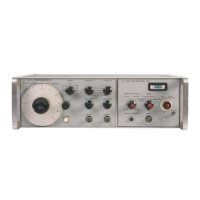Model 3300A Section V
CAUTION
TO AVOID SURFACE
CONTAMINATION OF THE PRINTED
CIRCUIT, CLEAN WITH A WEAK
SOLUTION OF WARM WATER AND
MILD DETERGENT AFTER REPAIR.
RINSE THOROUGHLY WITH CLEAN
WATER AND ALLOW IT TO DRY
COMPLETELY BEFORE OPERATING.
DO NOT USE ALCOHOL OR ANY
OTHER CLEANING SOLUTION
EXCEPT DETERGENT AND WATER.
DO NOT APPLY ANY COMMERCIAL
MOISTURE SEALING SPRAY TO THE
BOARDS. APPLICATION OF THESE
AGENTS WILL CAUSE LEAKAGE
PATHS AND SUBSEQUENTLY,
DETERIORATION TO THE
OPERATION OF THE INSTRUMENT.
f. Wear clean, lint free cotton or rubber gloves
when handling the circuit boards. Avoid
touching the board or components with
bare fingers as skin oils can cause
contamination and leakage paths.
5-46. SERVICING ROTARY SWITCHES.
5-47. The 3300A has three rotary type switches;
RANGE, CHANNEL A, and CHANNEL B. When working
on these switches, observe the following rules:
a. Use a low-heat (25 to 50 watts) small tip
soldering iron, and a small diameter rosin
core solder.
b. When replacing components, attempt to
dress them as nearly to their original
alignment as possible.
c. Clean excessive flux from the connection
and adjoining area.
5-48. REPLACEMENT OF FACTORY SELECTED
COMPONENTS.
5-49. Replacement components are identified in Table
5-3 and 5-6. Should it become necessary to replace any
of the capacitors in the feedback circuit of the Triangle
Integrator, the replacement capacitor (a good quality
polycarbonate or mica film type) must be selected so that
the approximate parallel capacitance is as indicated in
Table 5-3. If after capacitor replacement, the resultant
frequency is not correct, the necessary capacitor change
can be determined by the following formula:
C
correction = C feedback
(Freq - desired Freq X100
desired Freq
Example: X1K range inaccurate
Freq of 9.8 kHz (Range X1K dial 10)
C
correction = 0.011
µ
F
(9.8K - 10K) X100
10K
= -0.011
µ
F = -.00137
µ
F
8
5-50. TROUBLESHOOTING PROCEDURE.
5-51. This section contains procedures designed to
assist in the isolation of a malfunction. These
procedures are based on a systematic analysis of the
instrument in an effort to localize the problem. These
operations should be undertaken only after it has been
established that the difficulty cannot be eliminated by the
adjustment and calibration procedures outlined in
Paragraph 5-21.
5-52. Conduct a visual check of the 3300A for possible
burned or loose components, loose connections, or any
other obvious condition which might be a source of
trouble. An investigation should also be made to ensure
that the trouble is not a result of conditions external to
the 3300A.
5-53. The checks outlined in this section are not
designed to measure all circuit parameters, rather only to
localize the malfunction. Therefore, it is highly probable
that additional checks and measurements will be
required to completely isolate the faulty component.
Amplifier gain may also vary slightly between
instruments; therefore, it is not necessary to precisely
duplicate waveforms or voltages described.
5-54. MALFUNCTION ISOLATION PLUG.
5-55. A malfunction isolating tool can be fabricated for
isolating a malfunction to the 3300A or the plug-in unit. A
50 pin connector -hp- Part No. 1251-0099 can be fitted
with 4 jumpers (see Figure 5-7 for
Table 5-3. Integrator Feedback Capacitance
DESIGNATED CAPACITORS PADDING CAPACITORS RANGE VALUE
C3 C16, C17, and possible C18 X.01, X1
11 µF
A13C13 C14 and C15 X.1, X10
1.1 µF
A13C10 C11 and C12 X100
0.11 µF
A13C7 C8 and C9 X1K
0.011 µF
A13C6 C5 X10K
0.0011 µF
5-7

